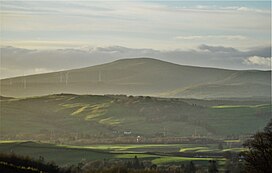| Queensberry | |
|---|---|
 | |
| Highest point | |
| Elevation | 697 m (2,287 ft) [1] |
| Prominence | 212 m (696 ft) [1] |
| Listing | Ma,Hu,Tu,Sim, G, D,DN,Y [2] |
| Coordinates | 55°16′55″N3°35′36″W / 55.28192°N 3.59321°W |
| Geography | |
 | |
| Location | Southern Uplands, Scotland |
| Parent range | Lowther Hills, Southern Uplands |
| OS grid | NX 98909 99746 |
| Topo map | OS Landranger 78 |
Queensberry is a hill in the Lowther Hills range, part of the Southern Uplands of Scotland. The most southerly mountain in the range, it lies in the parish of Kirkpatrick-Juxta [3] and is a prominent landmark throughout Dumfriesshire. It is frequently climbed from the Daer Reservoir to the north and the minor roads to its south and east. As well as being a placename of multiple addresses throughout southern Scotland, the hill also lend its name to the Duke of Queensberry and Marquess of Queensberry peerages [4] and, subsequently, 'Queensberry Rules' in the sport of boxing.